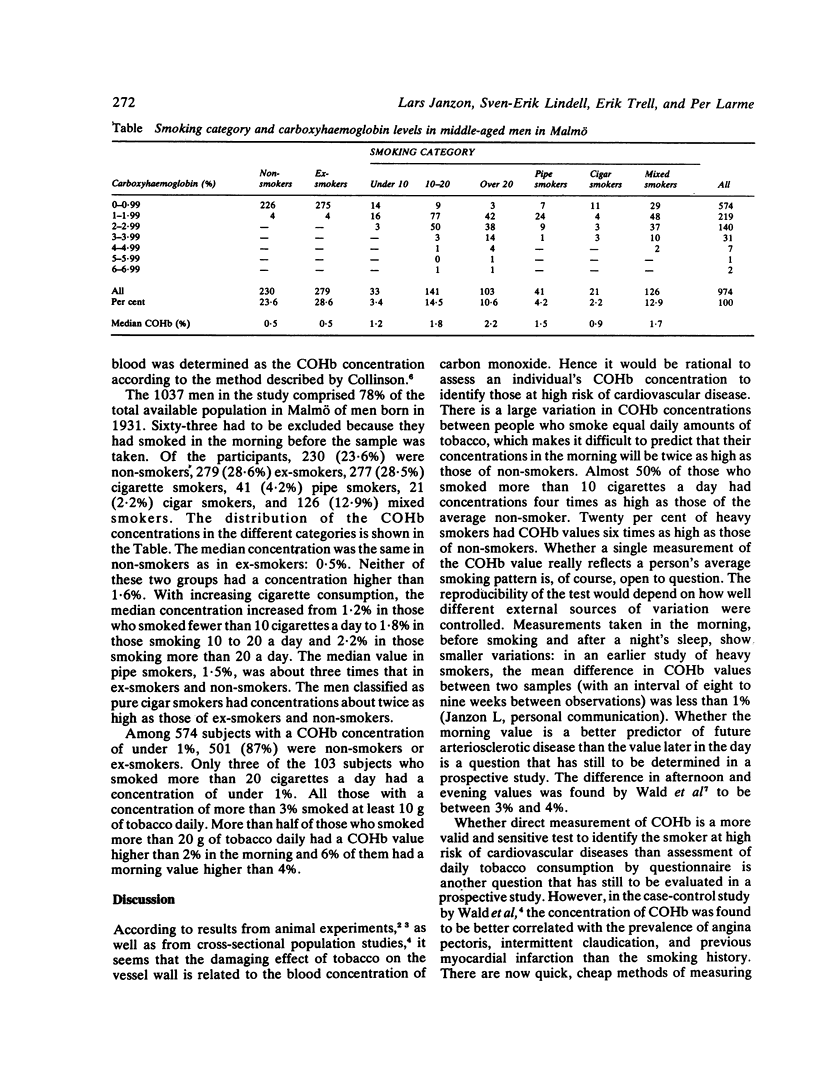Abstract
In this cross-sectional population study we report on the distribution of carboxyhaemoglobin concentrations in the morning, before smoking, in an urban population of 1037 men born in 1931. The median concentration was the same in non-smokers as in ex-smokers: 0.5%. It increased with increasing daily tobacco consumption. But when carboxyhaemoglobin concentrations are measured in reasonably well-standardised circumstances there are large variations between individuals, even in those who smoke equal amounts of tobacco a day. This makes it difficult to predict the concentration in the individual smoker when only his daily tobacco consumption is known. Measurements of carboxyhaemoglobin concentration should be a valuable complement to smoking history to identify the smoker at high risk of cardiovascular disease, to provide an extra argument to make the patient give up the habit, and to reinforce the efforts of those who try to do so.
Full text
PDF


Selected References
These references are in PubMed. This may not be the complete list of references from this article.
- Astrup P., Kjeldsen K., Wanstrup J. Enhancing influence of carbon monoxide on the development of atheromatosis in cholesterol-fed rabbits. J Atheroscler Res. 1967 May-Jun;7(3):343–354. doi: 10.1016/s0368-1319(67)80061-9. [DOI] [PubMed] [Google Scholar]
- Cohen S. I., Perkins N. M., Ury H. K., Goldsmith J. R. Carbon monoxide uptake in cigarette smoking. Arch Environ Health. 1971 Jan;22(1):55–60. doi: 10.1080/00039896.1971.10665815. [DOI] [PubMed] [Google Scholar]
- Schuman L. M. The benefits of cessation of smoking. Chest. 1971 Apr;59(4):421–427. doi: 10.1378/chest.59.4.421. [DOI] [PubMed] [Google Scholar]
- Thomsen H. K. Carbon monoxide-induced atherosclerosis in primates. An electron-microscopic study on the coronary arteries of Macaca trus monkeys. Atherosclerosis. 1974 Sep-Oct;20(2):233–240. doi: 10.1016/0021-9150(74)90008-2. [DOI] [PubMed] [Google Scholar]
- Wald N., Howard S. Letter: Variations in carboxyhaemoglobin levels in smokers. Br Med J. 1975 Feb 15;1(5954):393–393. doi: 10.1136/bmj.1.5954.393. [DOI] [PMC free article] [PubMed] [Google Scholar]
- Wald N., Howard S., Smith P. G., Bailey A. Use of carboxyhaemoglobin levels to predict the development of diseases associated with cigarette smoking. Thorax. 1975 Apr;30(2):133–140. doi: 10.1136/thx.30.2.133. [DOI] [PMC free article] [PubMed] [Google Scholar]
- Wald N., Howard S., Smith P. G., Kjeldsen K. Association between atherosclerotic diseases and carboxyhaemoglobin levels in tobacco smokers. Br Med J. 1973 Mar 31;1(5856):761–765. doi: 10.1136/bmj.1.5856.761. [DOI] [PMC free article] [PubMed] [Google Scholar]


